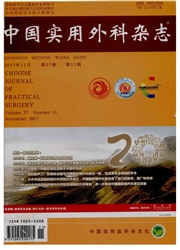

 中文摘要:
中文摘要:
影像学是评价胃肠间质瘤(gastrointestinal stromal tumor,GIST)靶向治疗疗效的主要手段。CT和MRI可方便、客观的反应GIST疗后改变,是目前临床应用最为广泛的影像学评估方法。靶向治疗有效的GIST病灶早期以出血、坏死、囊变及黏液变为主要表现,此时体积可能缩小不明显甚至增大,RECIST形态学标准应用受到限制。新近结合强化CT值变化率提出的Choi标准以及欧洲通过大样本随访研究制定的EORTC/ISG/AGITG联合标准,拓展了影像学对GIST靶向治疗疗效评价的理念。正电子发射断层显像(PET)及磁共振扩散加权功能成像可在更早期评价GIST靶向治疗疗效,有效组在初始治疗后1周内即可出现量化表征值的显著下降,成为GIST疗效评价及预测的潜力手段。
 英文摘要:
英文摘要:
Imageology is the primary method to evaluate the therapeutic effect of targeted therapy to gastrointestinal stromal tumor (GIST). CT and MRI can conveniently and objectively reflect the post-therapy alterations of GIST, which are the most prevailing modalities in clinical practices. The responder lesions of GIST post therapy mainly display hemorrhage, necrosis, cystic degeneration and mucinous degeneration at early stage, usually accompanied by insignificantly volume reduction, even enlarged lesions, which restrict the application of RECIST morphological criteria. It recently proposed Choi criteria which included CT value, and EORTC/ISG/AGITG criteria which based on large sample follow-up patients in Europe, has renewed radiology evaluating conceptions of GIST. PET and diffusion-weighted magnetic resonance imaging (DW-MRI) can detect the therapeutic response at earlier stage. The quantifieated apparent values significantly decreased post one week of initial therapies, which can be potential modalities in the evaluation and prediction of GIST therapeutic effect.
 同期刊论文项目
同期刊论文项目
 同项目期刊论文
同项目期刊论文
 Gastrointestinal Stromal Tumors Treated with Imatinib Mesylate: Apparent Diffusion Coefficient in th
Gastrointestinal Stromal Tumors Treated with Imatinib Mesylate: Apparent Diffusion Coefficient in th Support vector machine model for diagnosis of lymph node metastasis in gastric cancer with multidete
Support vector machine model for diagnosis of lymph node metastasis in gastric cancer with multidete 期刊信息
期刊信息
